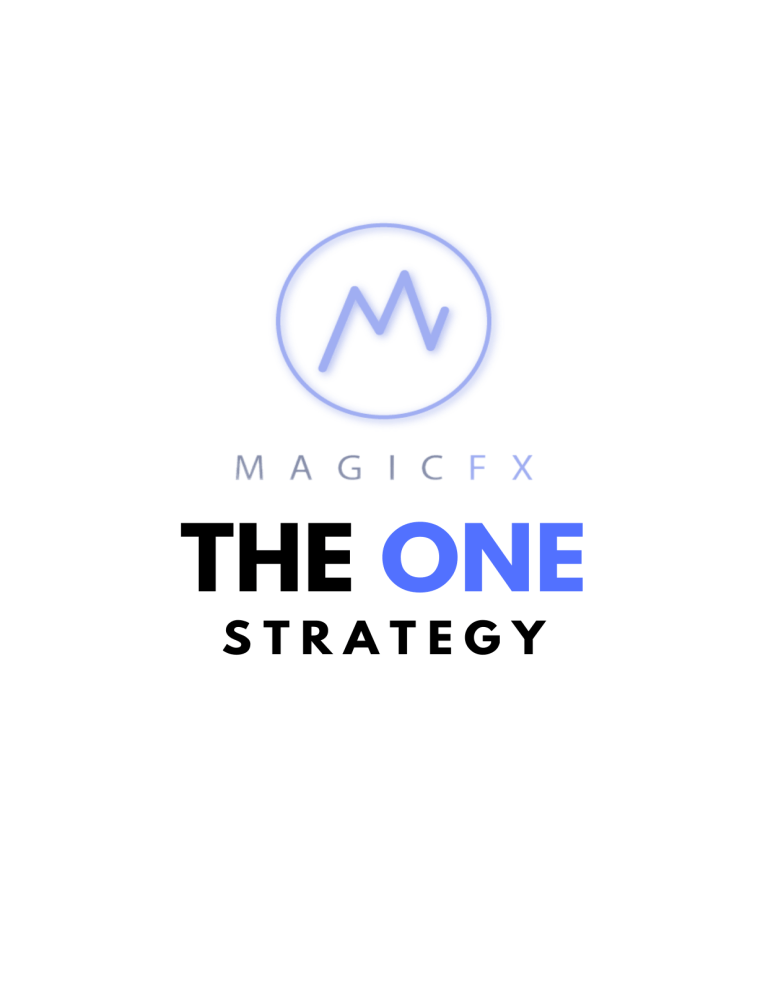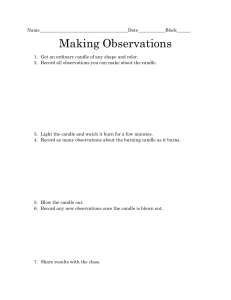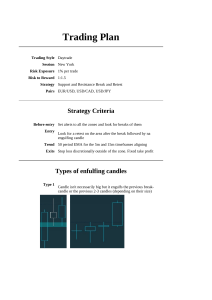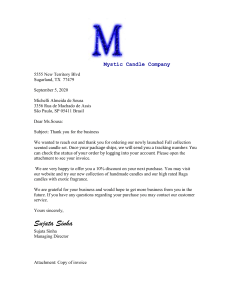
THE ONE STRATEGY ONE TIMEFRAME ONE ENTRY TYPE ONE PAIR ONE GOAL Welcome to simplicity STARTING FRESH The first thing I want you to do in order to successfully learn this method of trading, is to forget everything you know. I mean every single piece of technical analysis you've ever been taught. Liquidity, structure, orderflow, premium/ discount, EMA's, everything. Consider it all useless to you. Done? Ok good so that means you have a completely clear mind and will be free of bad habits... Well in an ideal world this would be true, however we are all human and falling into bad habits is what we do best. So consider this a warning: The hardest part of this strategy will be forgetting everything you knew before. Why? Because it will seem too simple, too stupidly easy and therefore just too damn good to be true to work on it's own, but that is the beauty of it. The simplicity is what allows it to be truly discretion free. It's what saves you from the psychological issues that plague most other strategies. So let's dive in. THE ONE TIMEFRAME A major part of the simplicity of this strategy is that it only focuses on one timeframe. That means no multitimeframe analysis, no confusing conflicts & no worrying about what happened 5 years ago. The only timeframe we will be studying is the 15 minute, and only the most recent price action, looking left is a thing of the past, we don't care about the past, only the present. The benefits of this are huge, first of all it makes things incredibly simple, you can open a chart and know within seconds what you are looking for. Secondly it means you don't need an expensive Tradingview premium account in order to analyse the markets, I mean, really you don't need Tradingview at all, it's simple enough that you could follow the candles purely on your MT4/MT5/Ctrader/whatever account. I personally still use Tradingview to backtest & out of habit (also because I paid for premium and I'll damn well use it until it runs out!). A NEW KIND OF STRUCTURE You may be confused when I say structure, didn't I tell you before to forget structure? Well yes I did but that's because this isn't structure as you previously knew it, this is structure in it's simplest form, and it requires following the lows and highs of candles in a very mechanical way. We will only ever need to follow one low and one high in price and that is the Current Confirmed Low and the Current Confirmed High. The simple rule is that a low is confirmed as soon as a candle trades above a candle to it's left and a high is confirmed once a candle trades below a candle to it's left. It doesn't need to close above/below the candle to it's left, it can just be a wick. This may sound confusing in just words so on the next page I will explain with images. FOLLOWING HIGHS & LOWS Here you can see a series of candles. within these candles there are a multitude of highs and lows that formed as price progressed. in the next image you can see how we would follow price using the previously mentioned "structure". EXPECTING RESPECT The theory behind why we look at price this way is that we are expecting bearish price to respect the high of the previous candle. Once the high of the previous candle is disrespected, we can confirm that we have had a sufficient enough movement to confirm a valid low. The same goes for bullish price, we expect the low of the candle to the left to be respected, and in the same way, if it is not, the we have sufficient movement to confirm a valid low. PRACTISING STRUCTURE First things first get the 15m charts up and create 2 horizontal rays. These will be your current low and current high. Now use Bar Replay to take price back as far as you like. Now you must locate your current confirmed high and low. For example see the image below: This is price at 17:45 (UK Time) on the 8th June 2023. Can you see where the current confirmed high and low would be? The answer will be on the following page. But try and work it out yourself before skipping ahead. Answer: If you got the same results, congratulations. If you didn't that's ok too. To find the current confirmed highs and lows all we need to do is start from the current candle and work backwards to the last time highs or lows were disrespected. Now let's move forward a few candles. Now we have broken the current confirmed low. do we now have a new confirmed low? No we do not, a new low is only confirmed once a previous candles high is disrespected. Such as a couple candles later in the image below: Now we have a new current confirmed low. It's also important to know, we don't need a break of the previous current confirmed low or high, in order to create a new one. As you can see on the following page, just a few candles later, we have created a new high without breaking the previous currently confirmed low or high. And then again, we have a new confirmed low here after price disrespected a low and then disrespected a high immediately after: Hopefully now you are getting the hang of it. It is very simple it just requires a little practise to get comfortable. ENTERING TRADES Believe it or not, the hard part is over with, once you have the structured sussed, you are 90% of the way there. The one simple way we enter trades with this strategy is to wait for a break and close above a current confirmed high for a long or below a current confirmed low for a short. Once price closes on the 15m and this one criteria is met, we enter at the closing price of last 15m candle. As shown below. Side note: If price only wicks above or below, you must wait for price to close below or above the candle to it's left before entering. STOP ORDERS The easiest and most foolproof way to enter using this strategy would be to just market execute at the close of a valid 15 minute candle. However from my backtesting I have found that a significant enough number of losses can be avoided by using stop orders for your entries instead. This requires waiting for price to pull back inside the previous candle body before placeing the stop order at the close of the previous candle. This way you will only be tagged in if price goes through your entry. If it continues to pull back and disrespects the high/low of the previous candle, you can remove the order. The only downside with this is that there will be times that you miss trades due to them not pulling back at all. The stop order entry doesn't require price to pull back a specific number of pips, it just requires it to pull back at all. RISK MANAGEMENT In terms of the technical analysis part of the strategy, we are done. Finished. Nothing else is required to know! But the analysis is not the most important part of this strategy, this is where risk management comes in. Now I have only thoroughly tested this on Gold (XAUUSD). It does work on other pairs (Such as GBPJPY) from a small amount of testing I've done, but I would recommend at least starting with just Gold and testing it for yourself. Now I can't tell you exactly how to trade it I can only tell you how I do, from what I've tested so on the following pages I will give you the simple rules I use to enter & manage my trades. However I encourage you to backtest this thoroughly to come to your own conclusions on what works best for YOU. STOP LOSS & RISK % The Stop Loss (SL) I use for this strategy on Gold is 27 pips. Now when I say 27 pips, on Tradingview this would be the equivalent of "2700" on the Risk Reward tool for Gold. Or in other words if I entered short at 1965.215, the SL would be at 1967.915. I risk 1% per trade and target 24 pips. So a maximum of 0.89% profit per trade. This sounds insane right? A lower Reward than the risk? Goes against probably everything you’ve ever been taught about trading! The proof is in the pudding though. With my backtesting this 27/24 ratio gives around a 67% winrate. The numbers do not lie and with the right risk management strategy, it is possible to make over 100% profit in a year using this strategy and Risk to Reward. Double Risk Strategy A fantastic way to both increase your profits and decrease your maximum drawdown, is to double your risk when in a certain amount of profit, and to halve it when you get to a certain drawdown value. From my data, mathematically it has been shown that you should double risk when above 2% profit, and halve risk when below 3%. For example, with a $100,000 account, I’d be risking $1000 (1%) per trade to begin with. As soon as the balance reached $102,000 I would start to risk $2000 (2%) per trade. If the balance fell below $102,000 again, I would go back down to $1000 risk. If the balance fell below $97,000 (-3%) I would start risking just $500 (0.5%) per trade until it was above $97,000 again. MOVING STOP LOSS When I first started using the one strategy, I was using a much smaller stop loss on gold. This increased the profits I would make from each trade and meant I would need a smaller winrate, however it did mean that there was way less margin for error as well as there being longer losing streaks and higher drawdown periods. Using the smaller SL psychologically, felt like I had a lot less room to breathe, and thus also I would cut my trades short by trailing the stop loss. Since using a bigger stop loss, I have found it to be much more relaxing psychology wise, as well as giving you that larger margin for error where spread plays a much smaller factor, and commissions are lower on the brokers that have them. The only thing I will do, is move the stop loss to breakeven as soon as the trade runs to 15 pips in profit. Purely from a data perspective, this has shown to be an effective addition to the risk management strategy. BACKTESTING Backtesting is a very important part of this strategy. Using just a single TF makes it very easy to backtest a large amount of data in a small amount of time. This means you can really put the work in to gaining a large sample size of data and refining the edge to your liking! This is what makes trading completely mathematical and you will finally know your winrate and how many losses you can expect to take in a row. This is how to actually beat emotions and the psychological game of trading. THE MAGICFX TRADING LAB In order to start backtesting properly you need a way to log your data, I have included a spreadsheet below for you to use to fill in your data. Access it here and make a copy: Backtesting Journal This is the next gen version of the MagicFX trading Journal and is incredibly powerful. To use it you must enter the date, time, Drawdown 1 (number of pips the trade went against you before going into profit), Profit 1 (The number of pips the trade went into profit before coming back to the entry price) drawdown 2 (number of pips the trade went against you after coming back to the entry price) Profit 2 (Number of pips the trade went into profit (If it went higher than profit 1 again). When I logged my data, I used 100 pips as a maximum drawdown, so if it went past that I would just log it as 100 as I wouldn’t use a SL bigger than that. PLEASE NOTE: The journal is still in a beta phase for the moment so not all features may work as intended. I am constantly refining it to make it the best and most accurate trading journal in the world. It will be automatically updated through the link in this book. The functionality of the journal is unparalleled and once you have logged a lot of data, you can easily experiment with different stop loss sizes, withdrawal amounts, commissions, spreads, number of trades per day amongst other features. But you MUST log a serious amount of data (1 year+) for it to be valuable. UPDATES NOVEMBER 2023 NY SESSION UPDATE A lot of people have been telling me for ages that the NY session works way better for XAU/USD, I somewhat stubbornly refused to accept this as I was happy with my London results, however I was recently approached with undeniable evidence not only performs well during NY but also performs better than London. This is using the following parameters: For the New York session, data has found that trading the NY session with the following parameters is ideal: Trading from 14:15 to 16:15 (UK time) is most profitable. The ideal Stop Loss is 27 pips, with a Take Profit of 29 pips. Avoid high impact news as shown on myfxbook economic calendar. (Don’t trade the candle directly before or during the news, after is fine. INSIDE BAR UPDATE After some serious testing, MagicFX member AVIX, has discovered that it is profitable to use inside bar (ib) breaks for entries in certain circumstances. I have assessed his data and come to the same agreement. Therefore we can now include this in the official guide. I will explain below. Note: If you are unsure of what an inside bar is, use the ibsv2 indicator on Tradingview and it will outline them for you. In short, it’s a candle that stays inside the candle to it’s left (neither breaks the high or low of it). INSIDE BAR STRUCTURE The first point to make is that we don’t use every inside bar that we come across for a confirmed high or low. The idea of using inside bars is to be able to get involved in trending price when it is moving with momentum. This will be most useful in the NY session when we get those big fundamental pushes. As the London session can be more rangey, the IB entry is more of a n optional add on. In order to differentiate one inside bar from another and to confirm trending price we must have at least 2 candles in a row that break the candle to their left in the same direction. After this occurs we can confirm the trend and start using the Inside Bar structure. Please see the image below: In the above image, we can see that we have had at least 2 candles in a row that have traded we would now treat the high of the candle before the inside bar as the confirmed high. Once the high of the IB is taken, the low of the IB is also confirmed. So if either the current confirmed low or high is closed below/above, then we can take trades as usual. So if taking the above example we would have: VALID IB CONTINUATION: VALID IB REVERSAL: So those examples are for a bullish trend and obviously the reverse would be true for a bearish trend with short continuations and long reversals. The important part is that in order to use the IB structure we must have those 2 breaks in the same direction beforehand (either wick or body). Want more? At MagicFX Academy we have a goal to be a hivemind of traders, taking the same entries, passing prop firm challenges and leveling up together. We are also working on an incredible one minute timeframe strategy that will blow your bollocks off. As a valued supporter of MagicFX I want to offer you a 50% discount code for the monthly membership so you can be a part of this experience. So use the code: MEMBER50 At checkout for a 50% discount! HERE



